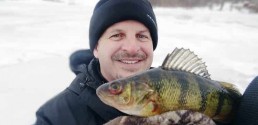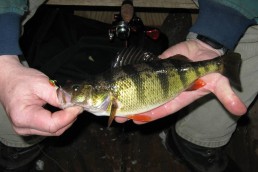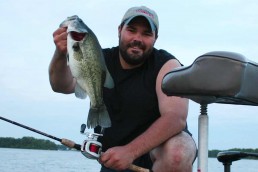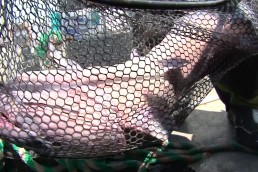Fish Deep, Soft-bottomed Basins for Jumbo Midwinter Perch
SHARE THIS POST
“There’s one!” yelled my friend Jeremy, as he set the hook.
I looked up from my Humminbird 688ci HD, which was lit up like a Christmas tree, to see a 10-inch perch come up Jeremy’s hole in the 24-inch thick ice.
“Man, they’re everywhere,” said my dad. He followed yelling, “Got one!”
Jeremy tossed his perch into the bucket and helped my father get his 11-incher into the house. A minute later our screens went blank, which finally allowed us time to get a deadstick set up with a crappie minnow in the house and two tip-ups set up outside the house.
Not long after we finished this, the screens on our sonar units lit up again and jumbo perch starting coming up the holes again. One walleye even grabbed a minnow suspended under one of the tip-ups during this spurt, and a couple big tulibees hammered our small jigs. We had my Clam Bigfoot XL 4000T hub shelter set up on Minnesota’s famed Mille Lacs Lake in early February. We were over a deep, soft-bottomed basin area, near a transition to harder bottom. Perch and tulibees were roaming the soft-bottom hunting larvae and minnows, and we hit an occasional walleye with tip-ups set on the hard-to-soft bottom transition line. As the schools of perch and tulibees roamed back and forth over the soft bottom, we had spurts and lulls. Our Humminbird flasher sonars always announced the arrival of a new school, as well as when a school had moved on—this is classic midwinter perch fishing.
Many large lakes in the upper Midwest grow big yellow perch, which provide some fantastic ice fishing opportunities. While you can certainly target jumbos in open water, most anglers spend more time chasing them on the ice. In midwinter, when the walleyes and the pike bite are slow, perch can be a great reason to keep heading out onto the ice. Anyone who has fried up some fresh perch from through the ice knows that it is a tough meal to beat.
Location is key to catching perch this time of year. As mentioned, perch roam deep-water soft-bottomed basin areas under the ice hunting for insect larvae, bloodworms and small minnows. In large natural lakes, these areas can be immense. At this point of the winter you should be able to drive on the lake, though snow cover can limit where a wheeled vehicle can go. You need to be mobile, and may need to drill dozens or up to hundreds of holes over a basin area, looking for fish on your sonar. No fish under a hole? Don’t fish that hole. If fish are there, then disappear and move to another hole. If you prefer to sit still, there are some areas that will attract fish, but they will still come and go so you will have to be patient. If there is a shallower, harder-bottomed hump or sunken island in a soft basin area, perch will usually be somewhere around this change in the bottom. In the opening, we were fishing the soft-bottom basin area near a harder-bottomed point that stuck out into the basin from a shoreline flat. As happened to us in the opener, if you choose to sit still in a high-percentage spot like this, you will experience spurts and lulls in the action. If you are not patient enough to wait out the lulls, then have lots of holes drilled and move from hole to hole trying to follow the schools of perch. We chose to sit in the comfort of a shelter that day because it was very cold and windy, which would have made sitting outside and moving from hole to hole a little more challenging. We would have been much less comfortable moving around outside, but probably would have caught even more fish than we did—“To each his own.”
Equipment for midwinter perch fishing is relatively simple. If you are going to be moving around, you could just carry your equipment in a 5-gallon bucket and kneel on the ice or sit on the bucket. You could also pull your equipment around in a portable shelter like a Clam Fish Trap. This gives you plenty of room for your equipment in a sled that easily moves around the ice, and a comfortable seat to sit on. It also allows you to flip over the top for a windbreak or to stay warmer on cold, windy days. A less portable shelter—like a Calm hub shelter—works well if you are going to sit it out on high-percentage spots. These shelters keep you protected from the wind, and a portable heater can make it quite comfortable, even on the coldest days, with Clam’s Thermal technology.
Are you enjoying this post?
You can be among the first to get the latest info on where to go, what to use and how to use it!
A good auger that starts easily and quickly drills lots of holes through thick ice is a must for chasing perch. There are several good options available. I choose StrikeMaster and will stick with them; they have never let me down.
A quality sonar unit and a mapping GPS unit are essential. The mapping GPS is extremely helpful for narrowing down areas to fish and then finding them. They also are helpful for marking areas that seem to hold fish much of the time so you can find these same spots the next time out. A quality, multi-color sonar helps ensure you are fishing where there are fish, and for distinguishing small from large fish, as well as fish hanging tight to the bottom. You also must learn to read your flasher to see how fish react to your presentation so you can fine-tune to what the fish react positively to. I use a Humminbird 688ci HD, which combines a flasher, LCD display sonar and mapping GPS. Once on the fish, my clients use the Humminbird ICE 55, which in my opinion, is the best multi-color ice fishing sonar available.
Perch can be very aggressive at times, and at other times more finicky than midwinter, midday bluegills. I have rods rigged with Jigging Raps, jigging spoons and rattling jig heads large enough to be tipped with a minnow for aggressive perch. I also have rods rigged with small horizontal jigs like a Gill Pill or VMC Tungsten Tubby that I can tip with a waxworm, euro larvae or soft plastic. These look like sunfish offerings, but work remarkably well for perch that are finicky to negative. I like to have one deadstick set near where I am jigging rigged with a live crappie minnow suspended under a float. Sometimes this catches fish, but I believe the struggling minnow always draws fish to my area, even if I have to finesse them with the jigging rod. I use light-power spinning combos for active perch and ultralight power inline combos with the tiny offerings for finicky fish. The inline reels don’t twist up the line like a spinning reel, which eliminates your jig spinning and possibly spooking the negative mood fish. I use medium-light power-spinning combos for the live minnow under a float, as this gives you enough backbone to land a walleye or large tulibee that may take the minnow. Ice anglers are fortunate to have a wide variety of quality ice fishing rods and reels to choose from that fit every budget. Most of my ice fishing combos are made up of Clam, St. Croix and Pflueger products.
That day, we were able to wait out several short lulls then experience multiple schools of big perch on the feed and even a few schools of aggressive, large tulibees. We caught hundreds of nice fish that day from the comfort of my heated Clam, and brought home a couple nice fish fries—again, tough to beat perch through the ice for a meal.
Get out on the ice on one of the large natural lakes in your area this February to chase some big perch. Try the techniques detailed above and have a blast catching some hard-fighting, great-tasting fish. As always, be careful out on the ice. MWO
Troy Smutka is a central Minnesota fishing guide (greatdayonthewater.com) and a walleye tournament angler. Troy is also a member of the Lund Boats, Mercury Outboards, and Johnson Outdoors Pro Teams.
MWO
SHARE THIS POST
Did you enjoy this post?
You can be among the first to get the latest info on where to go, what to use and how to use it!
Troy Smutka
Troy Smutka is a central Minnesota fishing guide (greatdayonthewater.com) and a walleye tournament angler. He is also a member of the Lund Boats, Mercury Outboards and Johnson Outdoors Pro Teams, and hosts and produces Fishing and Hunting the North Country on YouTube.



